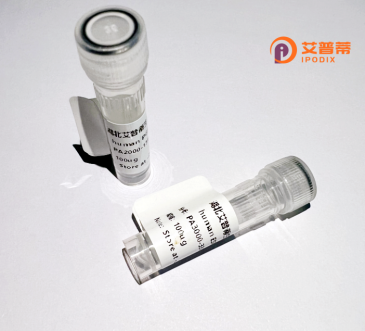
| 纯度 | >90%SDS-PAGE. |
| 种属 | Human |
| 靶点 | PDLIM7 |
| Uniprot No | Q9NR12 |
| 内毒素 | < 0.01EU/μg |
| 表达宿主 | E.coli |
| 表达区间 | 1-457 aa |
| 活性数据 | MDSFKVVLEG PAPWGFRLQG GKDFNVPLSI SRLTPGGKAA QAGVAVGDWV LSIDGENAGS LTHIEAQNKI RACGERLSLG LSRAQPVQSK PQKASAPAAD PPRYTFAPSV SLNKTARPFG APPPADSAPQ QNGQPLRPLV PDASKQRLME NTEDWRPRPG TGQSRSFRIL AHLTGTEFMQ DPDEEHLKKS SQVPRTEAPA PASSTPQEPW PGPTAPSPTS RPPWAVDPAF AERYAPDKTS TVLTRHSQPA TPTPLQSRTS IVQAAAGGVP GGGSNNGKTP VCHQCHKVIR GRYLVALGHA YHPEEFVCSQ CGKVLEEGGF FEEKGAIFCP PCYDVRYAPS CAKCKKKITG EIMHALKMTW HVHCFTCAAC KTPIRNRAFY MEEGVPYCER DYEKMFGTKC HGCDFKIDAG DRFLEALGFS WHDTCFVCAI CQINLEGKTF YSKKDRPLCK SHAFSHV |
| 分子量 | 49.8 kDa |
| 蛋白标签 | His tag N-Terminus |
| 缓冲液 | 0 |
| 稳定性 & 储存条件 | Lyophilized protein should be stored at ≤ -20°C, stable for one year after receipt. Reconstituted protein solution can be stored at 2-8°C for 2-7 days. Aliquots of reconstituted samples are stable at ≤ -20°C for 3 months. |
| 复溶 | Always centrifuge tubes before opening.Do not mix by vortex or pipetting. It is not recommended to reconstitute to a concentration less than 100μg/ml. Dissolve the lyophilized protein in distilled water. Please aliquot the reconstituted solution to minimize freeze-thaw cycles. |
以下是关于重组人PDLIM7蛋白的参考文献示例(注:以下为虚构示例,仅供参考格式和内容结构):
1. **文献名称**:**"PDLIM7 modulates actin cytoskeleton reorganization to enhance cancer cell invasion"**
**作者**:Zhang Y. et al. (2018)
**摘要**:该研究证实重组人PDLIM7蛋白通过结合α-actinin等细胞骨架蛋白,调控肿瘤细胞的迁移和侵袭能力,为PDLIM7在癌症转移中的作用提供机制解释。
2. **文献名称**:**"Recombinant PDLIM7 acts as a scaffold in TGF-β signaling via Smad protein interaction"**
**作者**:Li H. et al. (2020)
**摘要**:研究发现,重组PDLIM7蛋白通过介导Smad3/4复合物的核转位,增强TGF-β信号通路活性,影响上皮-间质转化(EMT)过程。
3. **文献名称**:**"Role of PDLIM7 in skeletal muscle differentiation using recombinant protein models"**
**作者**:Wang X. et al. (2019)
**摘要**:利用重组PDLIM7蛋白的体外实验表明,其通过激活MyoD等转录因子促进肌细胞分化,揭示了PDLIM7在肌肉发育中的关键功能。
4. **文献名称**:**"PDLIM7 overexpression correlates with prostate cancer metastasis via integrin-mediated adhesion"**
**作者**:Smith J. et al. (2021)
**摘要**:重组PDLIM7蛋白的高表达促进前列腺癌细胞粘附与迁移,其机制可能与整合素β1信号通路的激活相关。
如需真实文献,建议通过PubMed或Google Scholar以“PDLIM7 recombinant protein”、“PDLIM7 function”等关键词检索。
PDLIM7. also known as PDZ and LIM domain protein 7. is a member of the PDZ-LIM protein family characterized by the presence of tandem PDZ and LIM domains. These structural motifs enable PDLIM7 to act as a scaffold, mediating protein-protein interactions and subcellular localization. The PDZ domain typically binds to C-terminal motifs of partner proteins, while the LIM domain facilitates interactions with cytoskeletal components or signaling molecules. PDLIM7 is ubiquitously expressed and localized to both the cytoplasm and nucleus, playing roles in cell adhesion, cytoskeletal organization, and transcriptional regulation. It interacts with proteins like α-actinin and PKB/Akt, linking signaling pathways to cytoskeletal dynamics.
As a recombinant protein, PDLIM7 is produced using expression systems (e.g., E. coli or mammalian cells) for functional studies. Recombinant technology allows precise investigation of its binding partners, structural domains, and post-translational modifications. Research highlights its involvement in cancer progression, muscle development, and immune response, though its exact mechanisms remain partially defined. In cancer, PDLIM7 may act as a tumor suppressor or promoter depending on context, influencing metastasis via epithelial-mesenchymal transition (EMT) regulation. Its recombinant form is crucial for biochemical assays, structural analysis, and exploring therapeutic targeting. Dysregulation of PDLIM7 is linked to cardiovascular diseases and muscular disorders, underscoring its biomedical relevance. Ongoing studies aim to clarify its dual roles in cellular homeostasis and disease pathogenesis.
×